Distribution and Characterization of Armillaria Complex in Atlantic Forest Ecosystems of Spain
Abstract
:1. Introduction
2. Materials and Methods
2.1. Collection of Fungi
2.2. Description of Armillaria-Infected Ecosystems
2.3. Fungus Identification and Diversity Analysis
2.3.1. Fungal Species Identification by RFLP-PCR
2.3.2. Fungal Population Analysis
2.4. Host Resistance
3. Results
3.1. Distribution of Armillaria spp.
3.2. Determination of Ecosystem Characteristics in Which Armillaria spp. Were Detected
3.3. Fungal Population Analysis by RFLP, SI and UP-PCR
3.4. Host Resistance
4. Discussion
5. Conclusions
Acknowledgments
Author Contributions
Conflicts of Interest
References
- Wingfield, M.J.; Coetzee, M.P.A.; Crous, P.W.; Six, D.; Wingfield, B.D. Fungal phoenix rising from the ashes? IMA Fungus 2011, 1, 149–153. [Google Scholar] [CrossRef]
- Guillaumin, J.J.; Mohammed, C.; Anselmi, N.; Courtecuisse, R.; Gregory, S.C.; Holdenrieder, O.; Intini, M.; Lung, B.; Marxmüller, H.; Morrison, D.; et al. Geographical distribution and ecology of the Armillaria species in western Europe. For. Pathol. 1993, 23, 321–341. [Google Scholar] [CrossRef]
- Pérez-Sierra, A.; Henricot, B. Identification of fungal species beyond morphology. Mycologist 2002, 16, 42–46. [Google Scholar] [CrossRef]
- Williams, R.E.; Shaw, C.G., III; Wargo, P.M.; Sites, W.H. Armillaria Root Disease. In Forest Insect and Disease Leaflet 78; USDA Forest Service: Washington, DC, USA, 1989. [Google Scholar]
- Cox, K.D.; Scherm, H.; Beckman, T.G. Armillaria root and crown rot. In Southeastern Peach Growers Handbook; Horton, D., Johnson, D., Eds.; Cooperative Extension Service, University of Georgia: Athens, GA, USA, 2005; pp. 162–166. [Google Scholar]
- Edmonds, R.L.; Agee, J.K.; Gara, R.I. Root Diseases. In Forest Health and Protection; Edmonds, R.L., Agee, J.K., Gara, R.I., Eds.; McGraw-Hill Companies, Inc.: New York, NY, USA, 2000; pp. 275–308. [Google Scholar]
- Wargo, P.M.; Harrington, T.C. Host stress and susceptibility. In Armillaria Root Disease; Shaw, C.G., III, Kile, G.A., Eds.; Agriculture Handbook No. 691; USDA Forest Service: Washington, DC, USA, 1991; pp. 88–101. [Google Scholar]
- Guillaumin, J.J.; Legrand, P. Armillaria root rots. In Infectious Forest Diseases; Gonthier, P., Nicolotti, G., Eds.; CAB International: Wallingford, UK, 2013; pp. 159–168. [Google Scholar]
- Kile, G.A. Armillaria root rot in eucalypt forests aggravated endemic disease. Pac. Sci. 1983, 37, 459–464. [Google Scholar]
- Mallett, K.I.; Volney, W.J.A. Relationships among jack pine budworm damage, selected tree characteristics, and Armillaria root rot in jack pine. Can. J. For. Res. 1990, 20, 1791–1795. [Google Scholar] [CrossRef]
- Entry, J.A.; Cromack, K.J.; Hansen, E.; Waring, R. Response of western coniferous seedlings to infection by Armillaria ostoyae under limited light and nitrogen. Phytopathology 1991, 81, 89–94. [Google Scholar] [CrossRef]
- Mallett, K.; Maynard, D. Armillaria root disease, stand characteristics, and soil properties in young lodgepole pine. For. Ecol. Manag. 1998, 105, 37–44. [Google Scholar] [CrossRef]
- Popoola, T.O.S.; Fox, R.T.V. In vitro growth response of Armillaria isolates to different carbohydrate sources. ASSET Ser. B 2003, 2, 29–37. [Google Scholar]
- Hood, I.A.; Kimberley, M.O. Impact of Armillaria root disease and the effect of thinning in a late-rotation Pinus. radiata plantation. For. Pathol. 2009, 39, 415–427. [Google Scholar] [CrossRef]
- Wargo, P.M.; Shaw, C.G., III. Armillaria root rot: the puzzle is being solved. Plant Dis. 1985, 6, 826–832. [Google Scholar] [CrossRef]
- Gerlach, J.P.; Reich, P.B.; Puettman, K.; Baker, T. Species, diversity, and density affects tree seedling mortality from Armillaria root rot. Can. J. For. Res. 1997, 27, 1509–1512. [Google Scholar] [CrossRef]
- Kromroy, K.W.; Blanchette, R.A.; Grigal, D.F. Armillaria species on small woody plants, small woody debris, and root fragments in red pine stands. Can. J. For. Res. 2005, 35, 1487–1495. [Google Scholar] [CrossRef]
- Bloomberg, W.J.; Morrison, D.J. Relationship of growth reduction in Douglas-fir to infection by Armillaria root disease in southeastern British Columbia. Phytopathology 1989, 79, 482–487. [Google Scholar] [CrossRef]
- Morrison, D.J.; Merler, H.; Norris, D. Detection, Recognition and Management of Armillaria and Phellinus Root Diseases in the Southern Interior of British Columbia; FRDA II Rep.; British Columbia; Ministry of Forests, Research Branch: Victoria, BC, Canada, 1991. [Google Scholar]
- Hood, I.A.; Sandberg, C.J. Armillaria—A hidden disease of Pinus radiata. N. Z. J. For. Sci. 1993, 38, 29–32. [Google Scholar]
- Redfern, D.B.; Filip, G.M. Inoculum and infection. In Armillaria Root Disease; Shaw, C.G., III, Kile, G.A., Eds.; Agriculture Handbook No. 691; USDA Forest Service: Washington, DC, USA, 1991; pp. 48–61. [Google Scholar]
- Kliejunas, J.T. A risk assessment of climate change and the impact of forest diseases on forest ecosystems in the Western United States and Canada. In Gen. Tech. Rep. PSW-GTR-236. Albany, CA: U.S. Department of Agriculture, Forest Service, Pacific Southwest Research Station; Pacific Southwest Research Station: Albany, CA, USA, 2011; p. 70. [Google Scholar]
- Baumgartner, K.; Coetzee, M.P.A.; Hoffmeister, D. Secrets of the subterranean pathosystem of Armillaria. Mol. Plant Pathol. 2011, 12, 515–534. [Google Scholar] [CrossRef] [PubMed]
- Korhonen, K. Interfertility and clonal size in the Armillariella mellea complex. Karstenia 1978, 18, 31–42. [Google Scholar]
- Bulat, S.A.; Mironenko, N.V. Species identity of the phytopathogenic fungi Pyrenophora teres Dreschler and P. graminea Ito & Kuribayashi. Mikol. Fitopatol. 1990, 24, 435–441. (In Russian) [Google Scholar]
- Nielsen, K.; Justesen, A.F.; Jensen, D.F.; Yohalem, D.S. Universally primed polymerase chain reaction alleles and internal transcribed spacer restriction fragment length polymorphisms distinguish two subgroups in Botrytis aclada distinct from B. byssoidea. Phytopathology 2001, 91, 527–533. [Google Scholar] [CrossRef] [PubMed]
- Meyling, N.V.; Elinberg, J. Isolation and characterization of Beauveria bassiana isolates from phylloplanes of hedgerow vegetation. Mycol. Res. 2006, 11, 188–195. [Google Scholar] [CrossRef] [PubMed]
- Pottinger, B.; Stewart, A.; Carpenter, M.; Ridgway, H.J. Low genetic variation detected in New Zealand populations of Phaeomoniella. chlamydospora. Phytopathol. Mediterr. 2002, 41, 199–211. [Google Scholar]
- Bulat, S.A.; Lúbeck, M.; Mironenko, N.V.; Jensen, D.F.; Lübeck, P.S. UP-PCR analysis and ITS1 ribotyping of Trichoderma and Gliocladium. Mycol. Res. 1998, 102, 933–943. [Google Scholar] [CrossRef]
- Aguín, O.; Mansilla, J.P.; Sainz, M.J. Intraspecific variation in Armillaria species from shrubs and trees in northwestern Spain. Phytopathol. Mediterr. 2004, 43, 299–304. [Google Scholar]
- Escofet, P.E.; Aguín, O.; Mansilla, J.P. Detección e identificación por técnicas moleculares de especies del género Armillaria a partir de muestras de suelo. Bol. San. Veg. Plagas. 2006, 32, 231–240. [Google Scholar]
- Oliva, J.; Suz, L.M.; Colinas, C. Ecology of Armillaria species in silver fir (Abies alba) stands of the Spanish Pyrenees. Ann. For. Sci. 2009, 66, 603. [Google Scholar] [CrossRef]
- Iturritxa, E.; León, M.; García-Serna, I.; Heppe, E.; García-Jiménez, J.; Pérez-Sierra, A. Distribution and ecology of Armillaria species in northern Spain. In Root and Butt Rots of Forest Trees, Proceedings of the IUFRO, Berkeley, CA, USA, 12 August 2007; Garbelotto, M., Gonthier, P., Eds.; The university of California: Berkeley, CA, USA, 2008. [Google Scholar]
- HAZI. El Bosque Vasco en Cifras. Available online: http://www.nasdap.ejgv.euskadi.eus/contenidos/informacion/inventario_forestal_2011/es_agripes/adjuntos/El%20bosque%20vasco%20en%20cifras%202011_2012.pdf (accessed on 26 January 2017).
- Basque Government. Available online: http://www.nasdap.ejgv.euskadi.eus/nota_prensa/2016/el-sector-forestal-madera-de-euskadi-genera-18-000-empleos-y-aporta-el-1-53-del-pib-vasco-segun-los-datos-aportados-por-el-libro-blanco-del-sector/r50-promocon/es/ (accessed on 26 January 2017).
- Mueller-Dombois, L.D.; Ellenberg, H. Measuring Species Quantities. In Aims and Methods of Vegetation Ecology; John Wiley and Sons: New York, NY, USA, 1974; pp. 67–92. [Google Scholar]
- Worrall, J.J. Media for selective isolation of Hymenomycetes. Mycologia 1991, 83, 296. [Google Scholar] [CrossRef]
- Pitt, J.I.; Hocking, A.D. Preservation of fungi. In Fungi and Food Spoilage, 3rd ed.; Springer: New York, NY, USA, 2009; pp. 48–50. [Google Scholar]
- Greenacre, M.; Hastie, T. The Geometric Interpretation of Correspondence Analysis. J. Am. Stat. Assoc. 1987, 82, 437–447. [Google Scholar] [CrossRef]
- Field, A.P. Discovering Statistics Using SPSS: (and Sex and Drugs and Rock ‘n’ Roll); SAGE Publications: London, UK, 2009. [Google Scholar]
- Harrington, T.C.; Wingfield, B.D. A PCR based identification method for species of Armillaria. Mycologia 1995, 87, 280–288. [Google Scholar] [CrossRef]
- Pérez-Sierra, A.; Whitehead, D.S.; Whitehead, M.P. Investigation of a PCR-based method for the routine identification of British Armillaria species. Mycol. Res. 1999, 103, 1631–1636. [Google Scholar] [CrossRef]
- Anderson, J.B.; Ullrich, R.C.; Roth, L.F.; Filip, G.M. Genetic identification of clones of Armillaria mellea in coniferous forests in Washington. Analysis 1979, 69, 1109–1111. [Google Scholar]
- Tyson, J.L.; Ridgway, H.J.; Fullerton, R.A.; Stewart, A. Genetic diversity in New Zealand populations of Sclerotium cepivorum. N. Z. J. Crop Hortic. Sci. 2002, 30, 37–41. [Google Scholar] [CrossRef]
- Lamboy, W.F. Computing genetic similarity coefficients from RAPD data: The effects of PCR artifacts. PCR Methods Appl. 1994, 4, 31–37. [Google Scholar] [CrossRef] [PubMed]
- Dunn, G.; Everitt, B.S. An introduction to Mathematical Taxonomy; Cambridge University Press: Cambridge, UK, 1982. [Google Scholar]
- Bulat, S.A.; Mironenko, N.V.; Lapteva, M.N.; Strelchenko, P.P. Polymerase chain reaction with universal primers (UP-PCR) and its application to plant genome analysis. In Conservation of Plant Genes II: Utilization of Ancient and Modern DNA; Adams, R.P., Miller, J.S., Goldenberg, E.M., Adams, J.E., Eds.; Missouri Botanical Garden: St. Louis, MO, USA, 1994; Volume 48, pp. 113–129. [Google Scholar]
- Bulat, S.A.; Lübeck, M.; Alekhina, I.; Jensen, D.F.; Knudsen, I.M.B.; Lübeck, P.S. Identification of an UP-PCR derived marker for an antagonistic strain of Clonostachys rosea and development of a strain-specific PCR detection assay. Appl. Environ. Microbiol. 2000, 66, 4758–4763. [Google Scholar] [CrossRef] [PubMed]
- Lübeck, P.S.; Alekhina, I.A.; Lübeck, M.; Bulat, S.A. UP-PCR genotyping and rDNA analysis of Ascochyta pisi Lib. J. Phytopathol. 1998, 146, 51–55. [Google Scholar] [CrossRef]
- Lübeck, M.; Alekhina, I.A.; Lübeck, P.S.; Jensen, D.F.; Bulat, S.A. Delineation of Trichoderma harzianum into two different genotypic groups by a highly robust fingerprinting method, UP-PCR, and UP-PCR product cross hybridisation. Mycol. Res. 1999, 103, 289–298. [Google Scholar] [CrossRef]
- Bulat, S.A.; Mironenko, N.V.; Zholkevich, Yu.G. Genetic structure of soil population of fungus Fusarium oxysporum Schlechtend.: Fr.: Molecular reidentification of the species and genetic differentiation of strains using polymerase chain reaction technique with universal primers (UP-PCR). Russ. J. Genet. 1995, 31, 271–278. [Google Scholar]
- Meyer, W.; Koch, A.; Niemann, C.; Beyermann, B.; Epplen, J.T.; Börner, T. Differentiation of species and strains among filamentous fungi by DNA fingerprinting. Curr. Genet. 1991, 19, 239–242. [Google Scholar] [CrossRef] [PubMed]
- Nogales, A.M. Estudio de la Interacción Entre el Hongo Formado de Micorrizas Arbusculares Glomus intraradices Schenck y Smith y el hongo patógeno Armillaria mellea (Vahl.:fr) P.Kuhn en vid. Doctoral Thesis, Universitat de Barcelona, Barcelona, Spain, 2009. [Google Scholar]
- Ferguson, B.A.; Dreisbach, T.A.; Parks, C.G.; Filip, G.M.; Schmitt, C.L. Coarse-scale population structure of pathogenic Armillaria species in a mixed-conifer forest in the Blue Mountains of northeast Oregon. Can. J. For. Res. 2003, 33, 612–623. [Google Scholar] [CrossRef]
- Worrall, J.J.; Sullivan, K.F.; Harrington, T.C.; Steimel, J.P. Incidence, host relations and population structure of Armillaria ostoyae in Colorado campgrounds. For. Ecol. Manag. 2004, 192, 191–206. [Google Scholar] [CrossRef]
- Bendel, M.; Kienast, F.; Rigling, D. Genetic population structure of three Armillaria species at the landscape scale: A case study from Swiss Pinus mugo forests. Mycol. Res. 2006, 110, 705–712. [Google Scholar] [CrossRef] [PubMed]
- Dodd, S.L.; Shah, F.H.; Hood, I.A. Molecular tools to determine the mode of spread of the root pathogen Armillaria in commercial pine forests. (Poster abstract AP-493). In Proceedings of the Joint Meeting of the American Phytopathological Society, Canadian Phytopathological Society, and the Mycological Society of America, Québec City, QC, Canada, 29 July–2 August 2006; (CD-ROM) American Phytopathological Society: St Paul, MN, USA, 2006. [Google Scholar]
- Pintos, C.; Aguín, O.; Mansilla, P.; Rial, C.; Sainz, M.J.; Salinero, M.C.; Mansilla, J.P. Diagnóstico de especies de Armillaria y Phytophthora en suelo como estrategia de conservación de árboles singulares en Galicia. In Montes: Servicio Y Desarrollo Rural, Proceedings of the 6° Congreso Forestal, Vitoria-Gasteiz, Spain, 10–14 June 2013; Sociedad Española de Ciencias Forestales: Madrid, Spain, 2014. [Google Scholar]
- Melo, M.J.; Machado, M.H.; Moniz, M. de F.; Bragança, M.H.; Sousa Santos, M.N. Resistance patterns of Cryptomeria japonica to Armillaria mellea in S. Miguel Island—Azores. In Proceedings of the Poster 4J Congresso da Sociedade Portuguesa de Fitopatologia, Universidade do Algarve, Faro, Portugal, 4–6 February 2004. [Google Scholar]
- Azevedo, N. Significance of rhizomorph formation of Armillaria mellea (Fr.) Kum. on Cryptomeria japonica (L.f.) D. Don in Azores. Phytopathol. Mediterr. 1976, 15, 73–77. [Google Scholar]
- Aguín, O.; Mansilla, J.P.; Sáinz, M.J. Patogenicidad de Armillaria mellea, Armillaria ostoyae y Armillaria gallica sobre coníferas. In Proceedings of the XII Congreso de la Sociedad española de fitopatología, Lloret de Mar, Spain, 26 September–1 October 2004. [Google Scholar]
- Hood, I.A.; Kimberley, M.O.; Gardner, J.F. Susceptibility to Armillaria novae-zelandiae among clones of Pinus radiata. For. Pathol. 2009, 39, 405–414. [Google Scholar] [CrossRef]
- Iturritxa, E. Análisis de la Sanidad y Desarrollo de Métodos de Protección de las Masas Forestales en la C.A.P.V. Available online: http://www.osakidetza.euskadi.eus/contenidos/documentacion/forpato/es_agripes/adjuntos/FORPATO2013.pdf (accessed on 6 May 2017).
- Butin, H. Tree Diseases and Disorders; Oxford University Press: Oxford, UK, 1995. [Google Scholar]
- Mesanza, N.; Iturritxa, E.; Patten, C.L. Native rhizobacteria as biocontrol agents of Heterobasidion annosum s.s. and Armillaria mellea infection of Pinus. radiata. Biol. Control. 2016, 101, 8–16. [Google Scholar] [CrossRef]
- Schwarze, F.W.M.R. Diagnosis and Prognosis of the Development of Wood Decay in Urban Trees; ENSPEC: Rowville, Australia, 2008; p. 336. [Google Scholar]
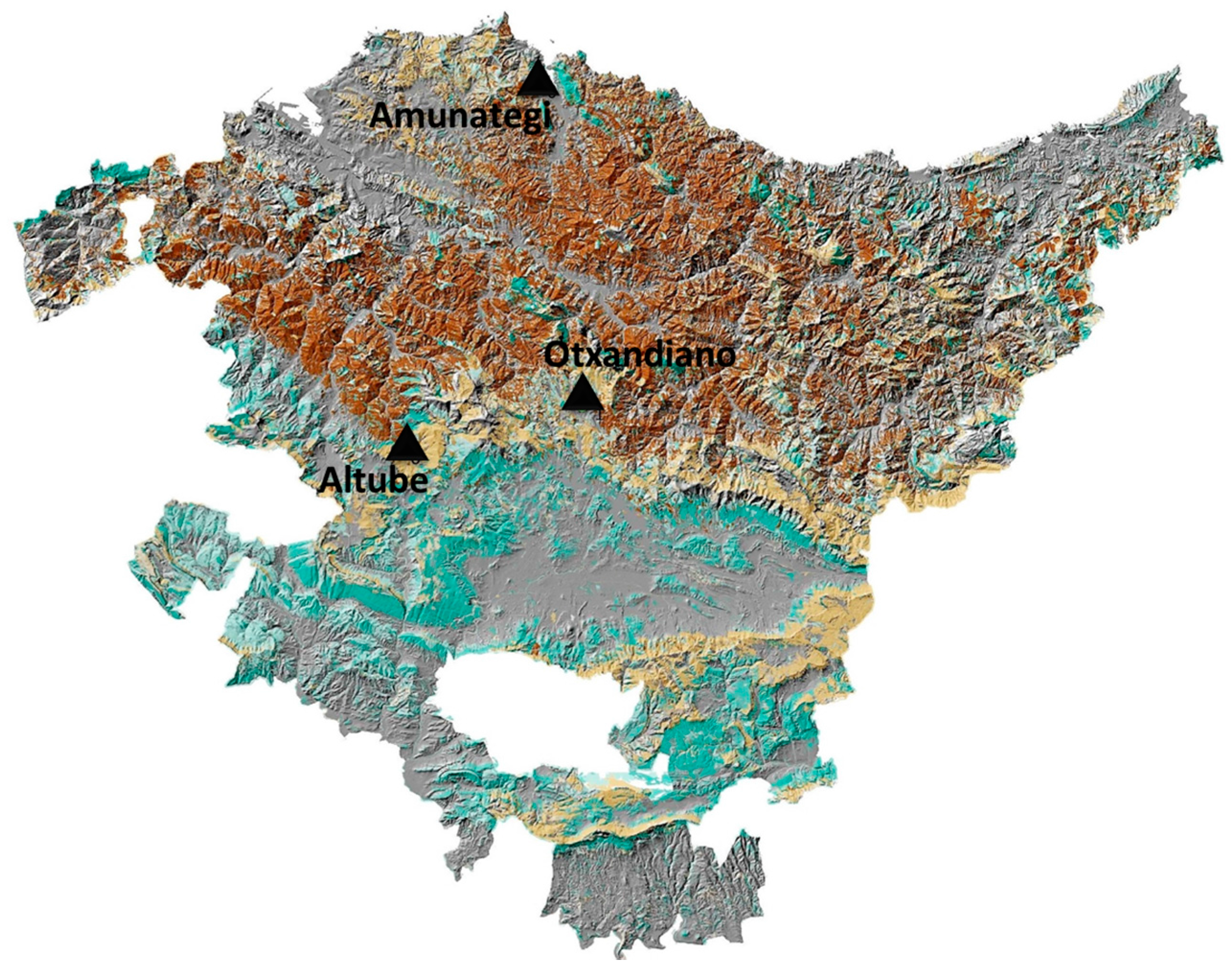
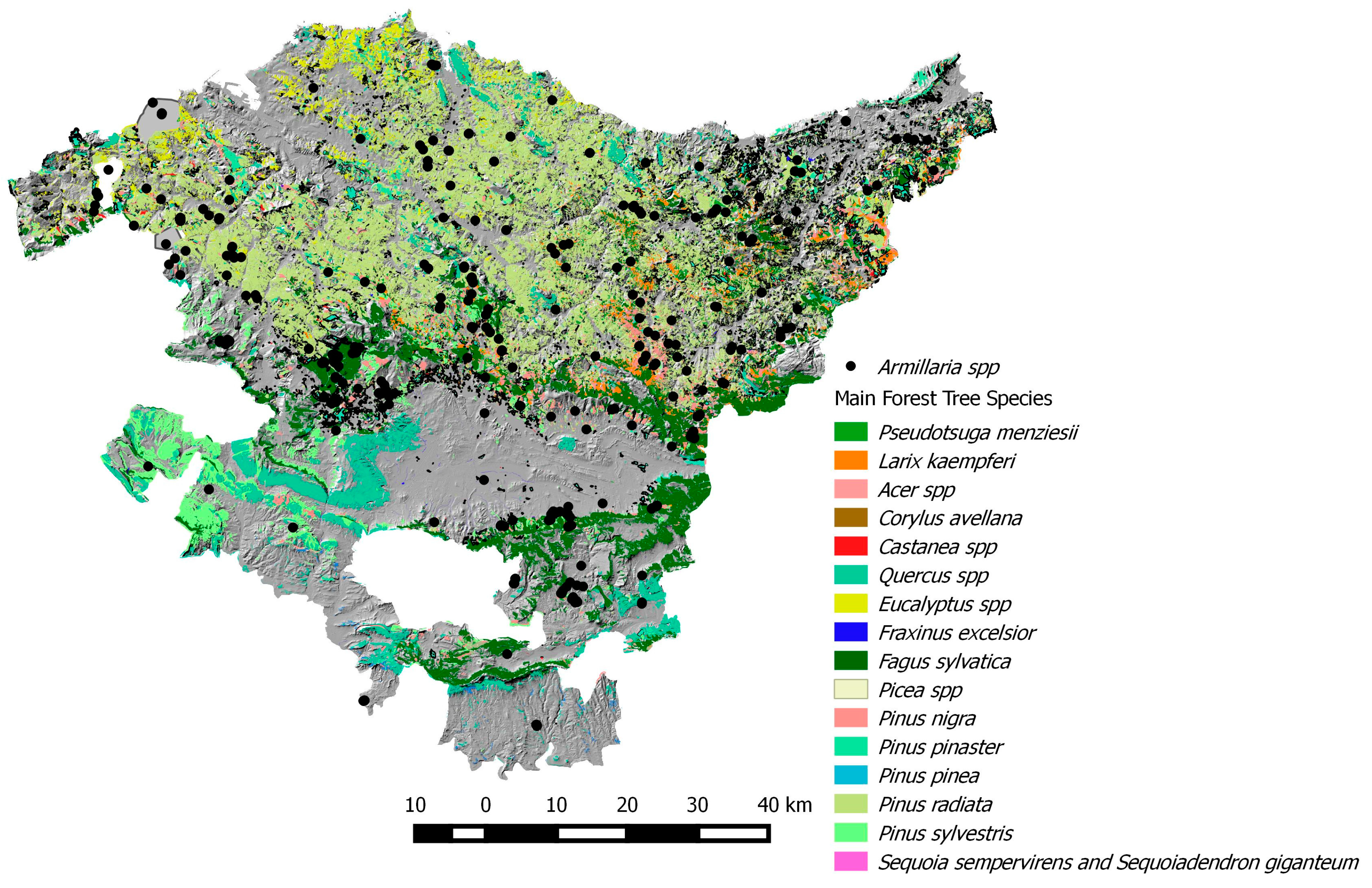
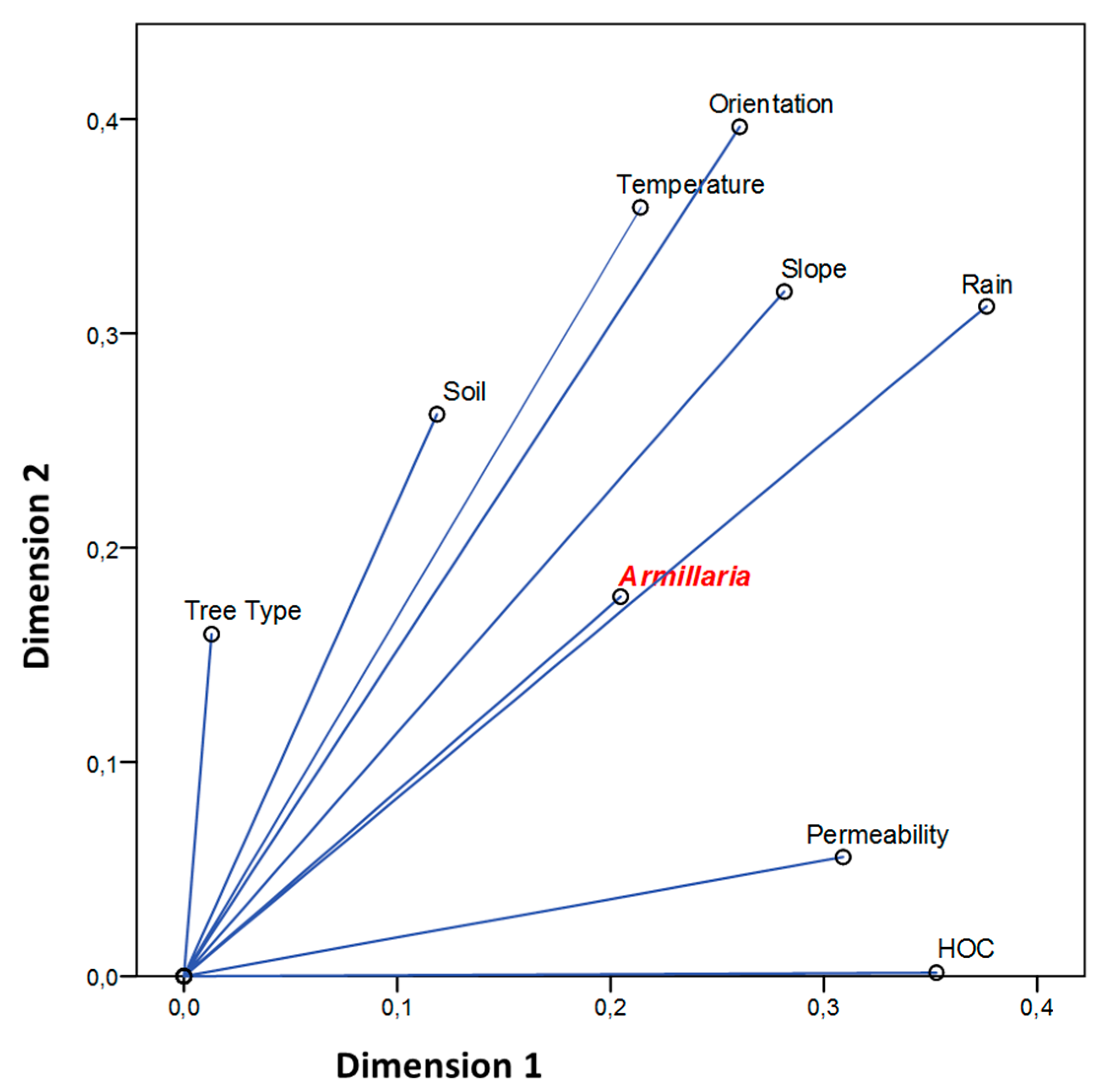
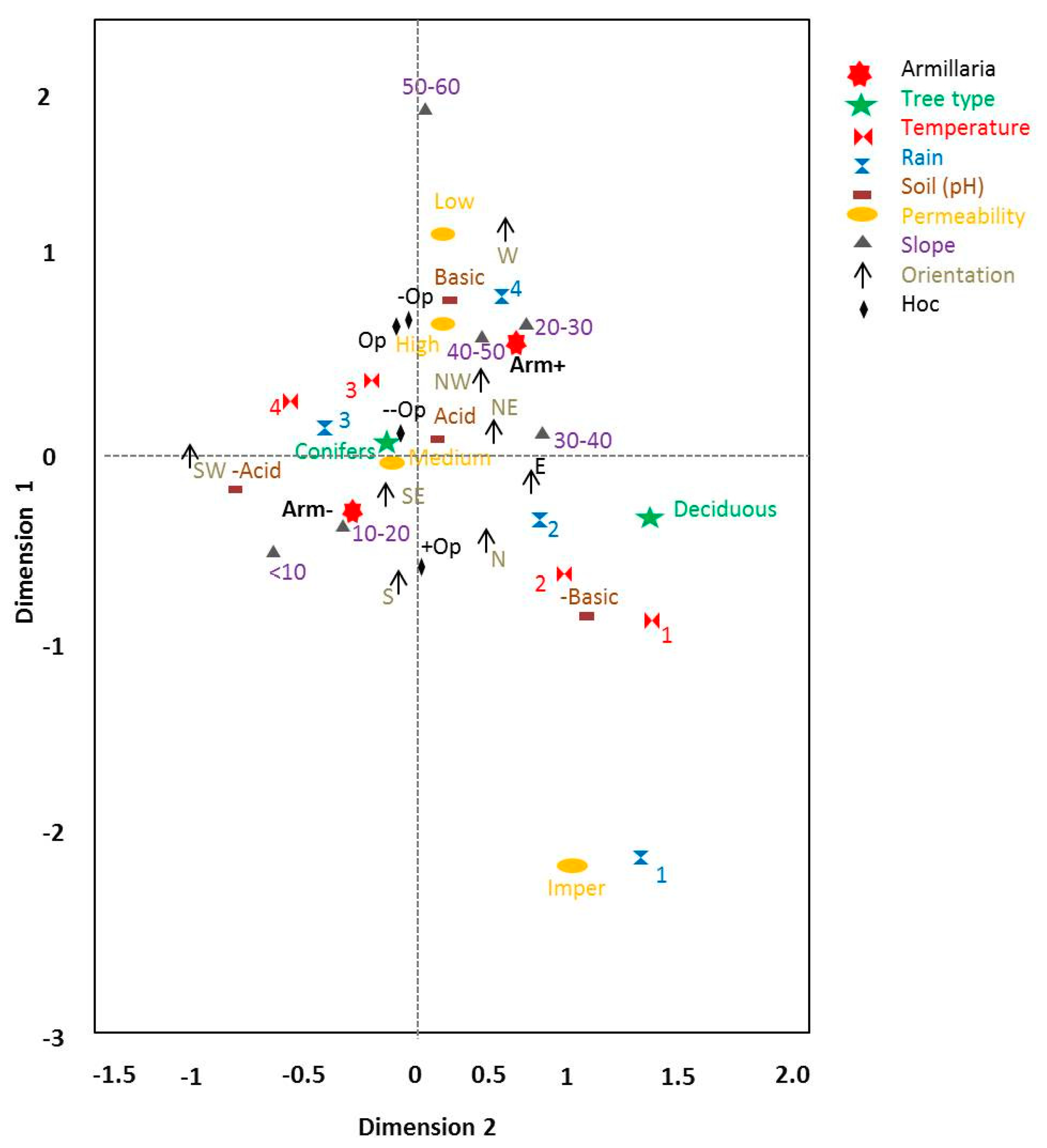
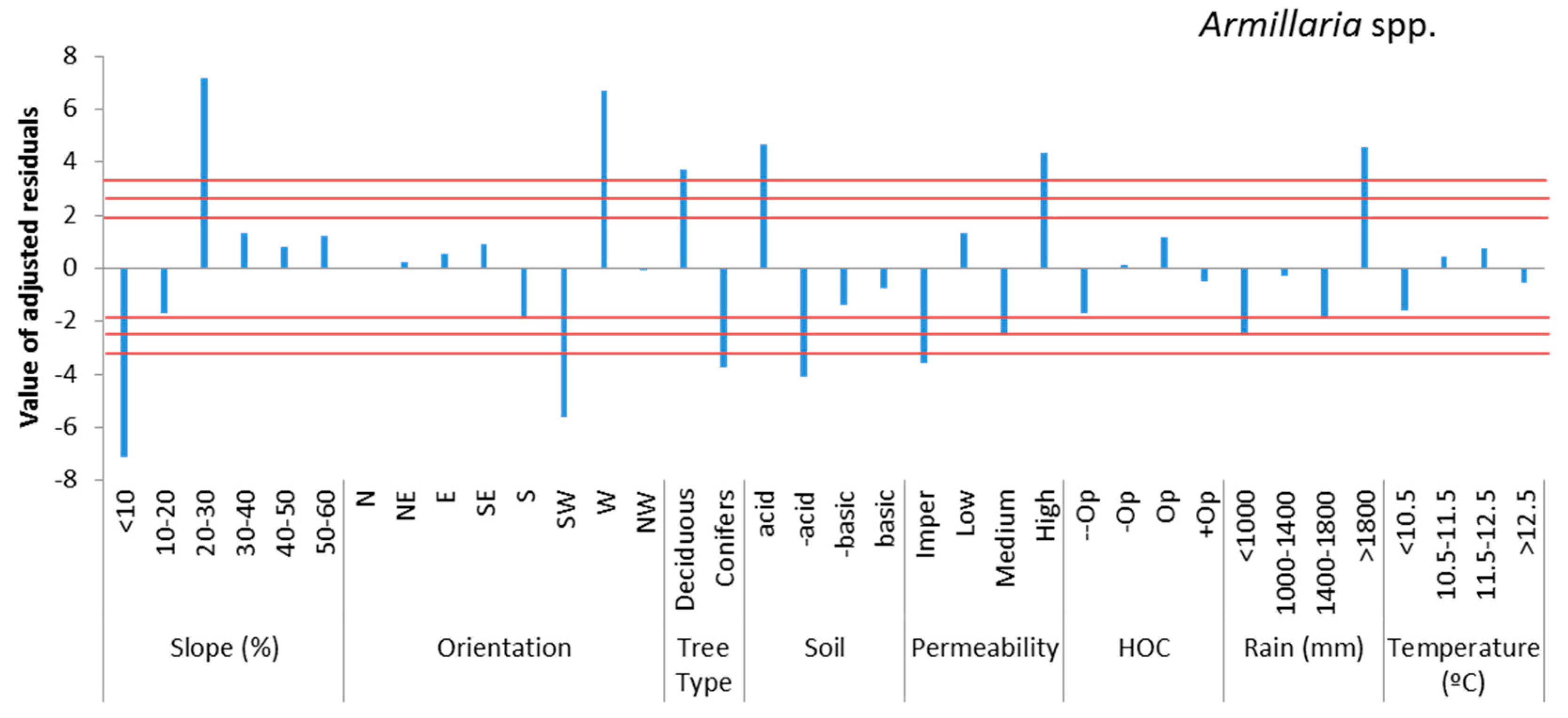
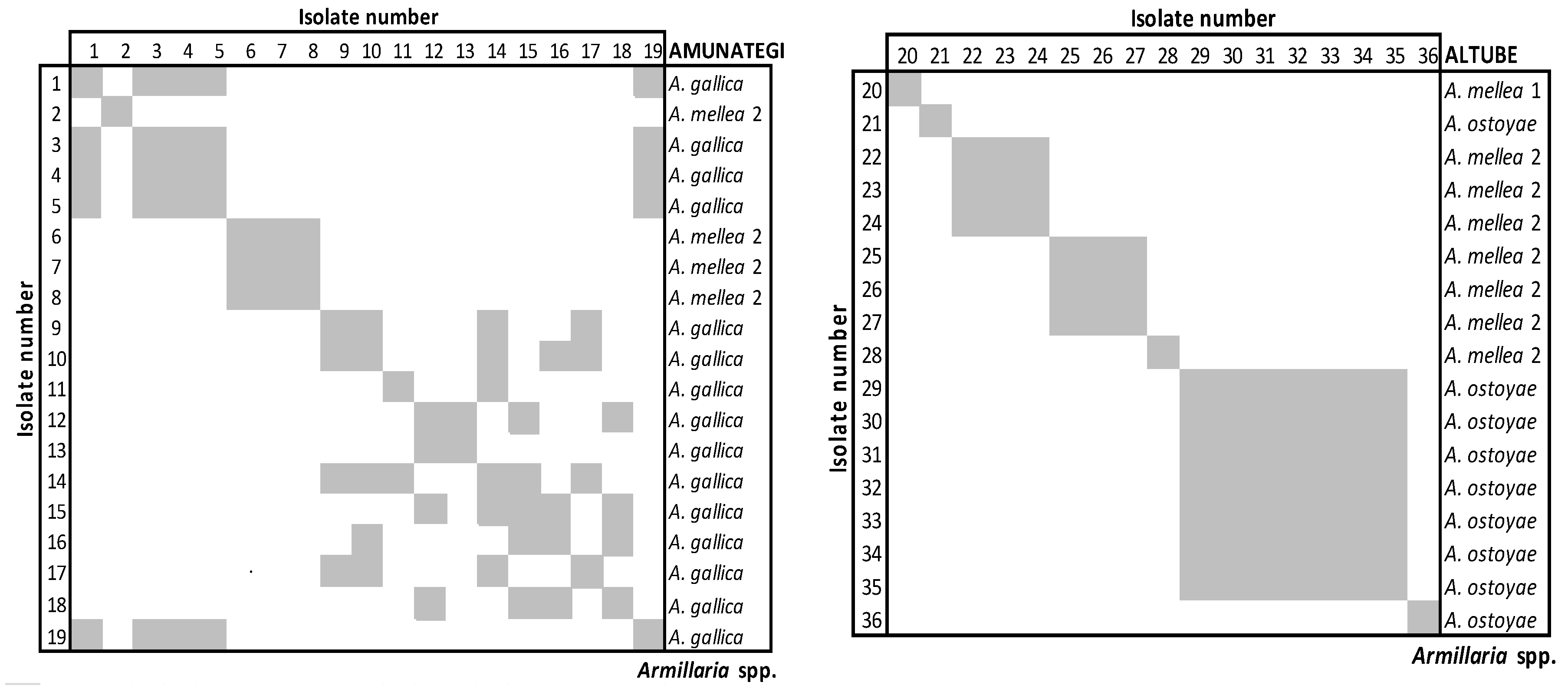
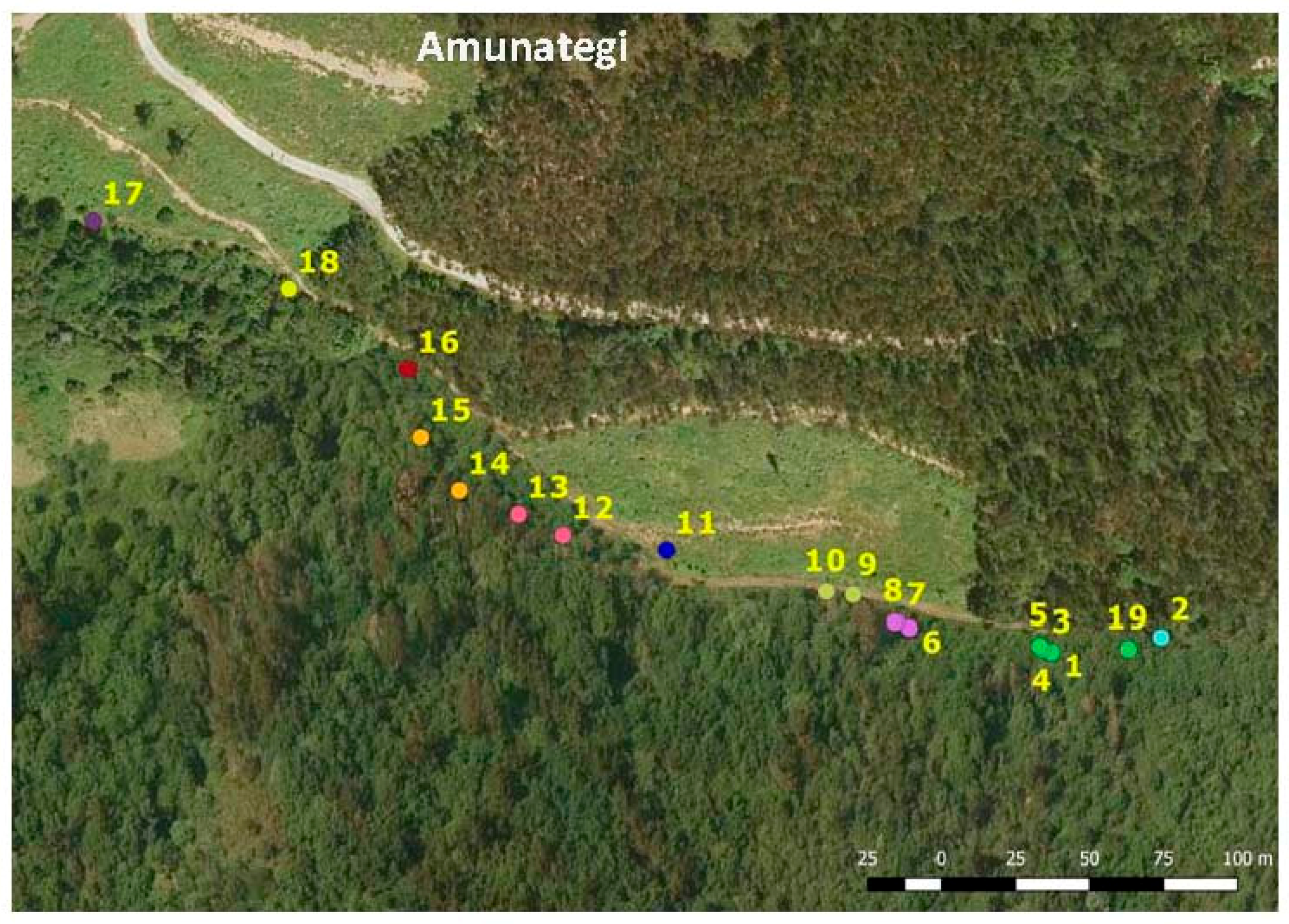
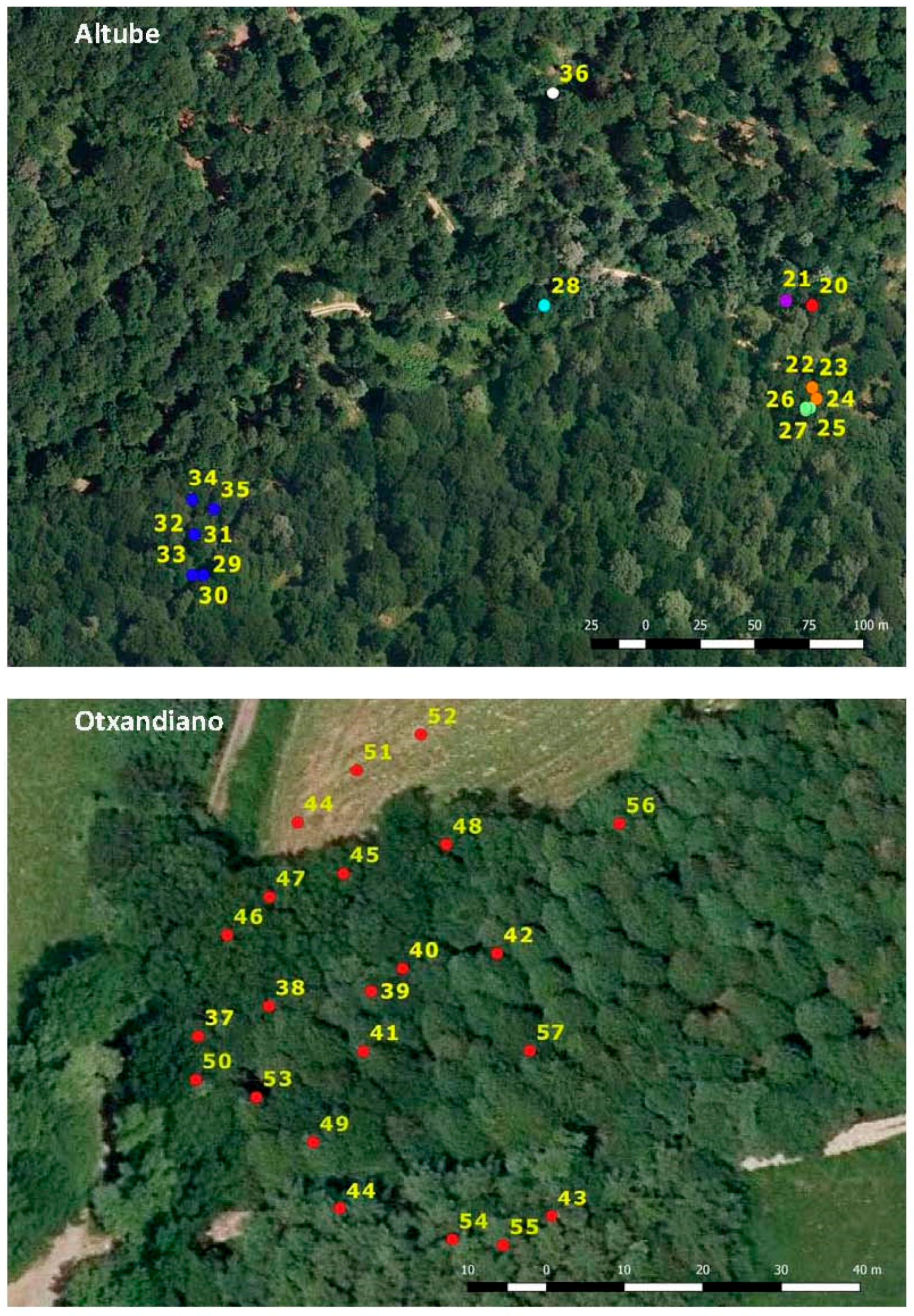
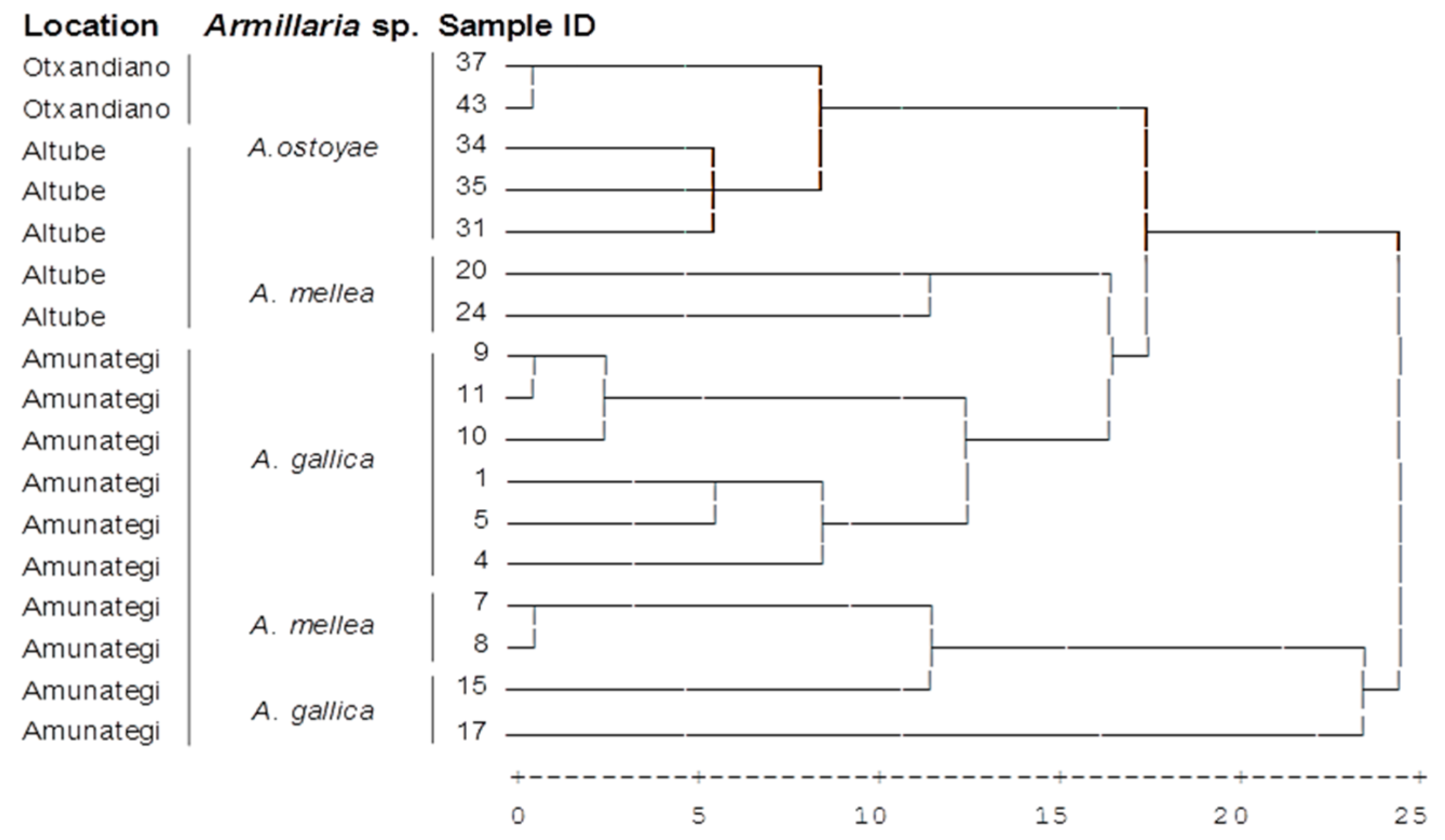
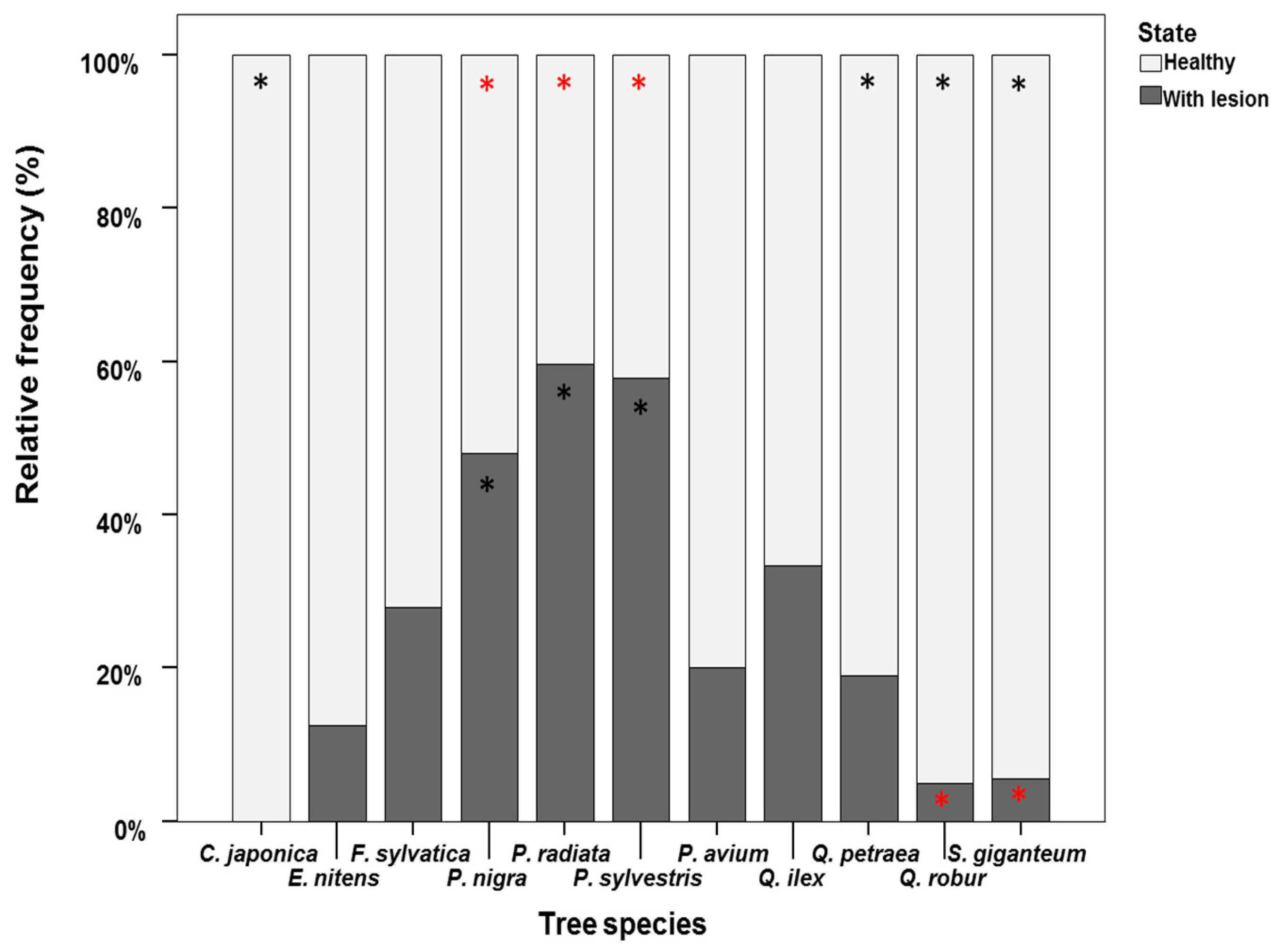
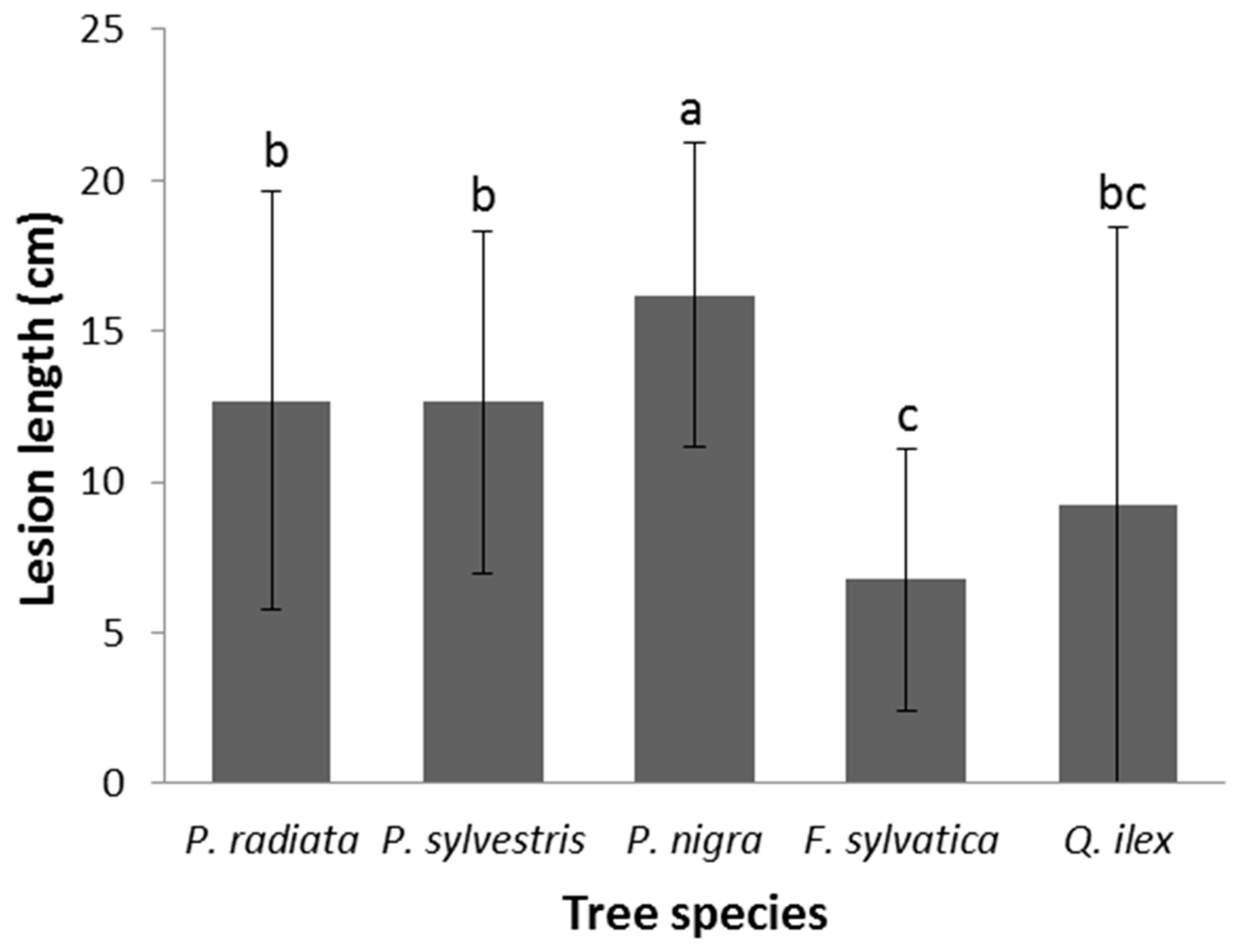
| Primer | Primer Sequence | Annealing Temp. (°C) | References |
|---|---|---|---|
| 0.3-1 | 5′-CGAGAACGACGGTTCT-3′ | 50 | [47] |
| 3.2 | 5′-TAAGGGCGGTGCCAGT-3′ | 52 | [47] |
| L45 | 5′-GTAAAACGACGGCCAGT-3′ | 51 | [29] |
| AS15inv | 5′-CATTGCTGGCGAATCGG-3′ | 52 | [48] |
| AA2M2 | 5′-CTGCGACCCAGAGCGG-3′ | 50 | [49] |
| AS4 | 5′-TGTGGGCGCTCGACAC-3′ | 55 | [49] |
| Fok1 | 5′-GGATGACCCACCTCCTAC-3′ | 52 | [49] |
| L15/AS19 | 5′-GAGGGTGGCGGCTAG-3′ | 52 | [50] |
| L21 | 5′-GGATCCGAGGGTGGCGGTTCT-3′ | 58 | [51] |
| M13 | 5′-GAGGGTGGCGGTTCT-3′ | 52 | [52] |
| AS15 | 5′-GGCTAAGCGGTCGTTAC-3′ | 52 | [47] |
| Characteristics | Category code | *Description | Detection of Armillaria disease | Number of foci | |
|---|---|---|---|---|---|
| Negative (Arm-) | Positive (Arm+) | ||||
| Slope (%) | <10 | <10 | 170 | 29 | 199 |
| 10–20 | 10<20 | 133 | 57 | 190 | |
| 20–30 | 20<30 | 89 | 111 | 200 | |
| 30–40 | 20<40 | 48 | 34 | 82 | |
| 40–50 | 40<50 | 18 | 13 | 31 | |
| 50–60 | 50<60 | 3 | 4 | 7 | |
| Tree Type | Deciduous | Deciduous | 28 | 36 | 64 |
| Conifers | Conifers | 433 | 212 | 645 | |
| Orientation | N | North | 45 | 24 | 69 |
| NE | Northeast | 46 | 26 | 72 | |
| E | East | 53 | 32 | 85 | |
| SE | Southeast | 39 | 26 | 65 | |
| S | South | 75 | 28 | 103 | |
| SW | Southwest | 133 | 26 | 159 | |
| W | West | 45 | 73 | 118 | |
| NW | Northwest | 25 | 13 | 38 | |
| Soil (Acidity) | acid | acid | 260 | 184 | 444 |
| -acid | -acid | 118 | 31 | 149 | |
| -basic | -basic | 46 | 17 | 63 | |
| basic | basic | 37 | 16 | 53 | |
| Permeability | Imper | Impermeable | 31 | 2 | 33 |
| low | Low | 4 | 5 | 9 | |
| medium | Medium | 364 | 175 | 539 | |
| high | High | 62 | 66 | 128 | |
| Rain (average, mm) | 1 | <1000 | 34 | 7 | 41 |
| 2 | 1000–1400 | 86 | 44 | 130 | |
| 3 | 1400–1800 | 295 | 141 | 436 | |
| 4 | >1800 | 46 | 56 | 102 | |
| Temperature (average, ºC) | 1 | <10.5 | 20 | 5 | 25 |
| 2 | 10.5–11.5 | 130 | 74 | 204 | |
| 3 | 11.5–12.5 | 162 | 94 | 256 | |
| 4 | >12.5 | 149 | 75 | 224 | |
| HOC (Host Optimal Conditions) | +Op | Favorable | 241 | 125 | 366 |
| Op | Acceptable | 171 | 103 | 274 | |
| -Op | Unfavorable | 23 | 13 | 36 | |
| --Op | Very Unfavorable | 26 | 7 | 33 | |
| Environmental Variables | df | χ2 | p-Value | Cramer’s V | Effect Size |
|---|---|---|---|---|---|
| Slope (%) | 5 | 79.2 | <0.001 | 0.334 | medium-large |
| Orientation | 7 | 65.5 | <0.001 | 0.304 | medium-large |
| Tree type | 1 | 14.0 | <0.001 | 0.140 | small-medium |
| Soil acidity | 3 | 23.6 | <0.001 | 0.183 | small-medium |
| Soil permeability | 3 | 30.8 | <0.001 | 0.208 | small-medium |
| Rainfall average (mm) | 3 | 25.0 | <0.001 | 0.188 | small-medium |
© 2017 by the authors. Licensee MDPI, Basel, Switzerland. This article is an open access article distributed under the terms and conditions of the Creative Commons Attribution (CC BY) license (http://creativecommons.org/licenses/by/4.0/).
Share and Cite
Mesanza, N.; Patten, C.L.; Iturritxa, E. Distribution and Characterization of Armillaria Complex in Atlantic Forest Ecosystems of Spain. Forests 2017, 8, 235. https://doi.org/10.3390/f8070235
Mesanza N, Patten CL, Iturritxa E. Distribution and Characterization of Armillaria Complex in Atlantic Forest Ecosystems of Spain. Forests. 2017; 8(7):235. https://doi.org/10.3390/f8070235
Chicago/Turabian StyleMesanza, Nebai, Cheryl L. Patten, and Eugenia Iturritxa. 2017. "Distribution and Characterization of Armillaria Complex in Atlantic Forest Ecosystems of Spain" Forests 8, no. 7: 235. https://doi.org/10.3390/f8070235
APA StyleMesanza, N., Patten, C. L., & Iturritxa, E. (2017). Distribution and Characterization of Armillaria Complex in Atlantic Forest Ecosystems of Spain. Forests, 8(7), 235. https://doi.org/10.3390/f8070235




